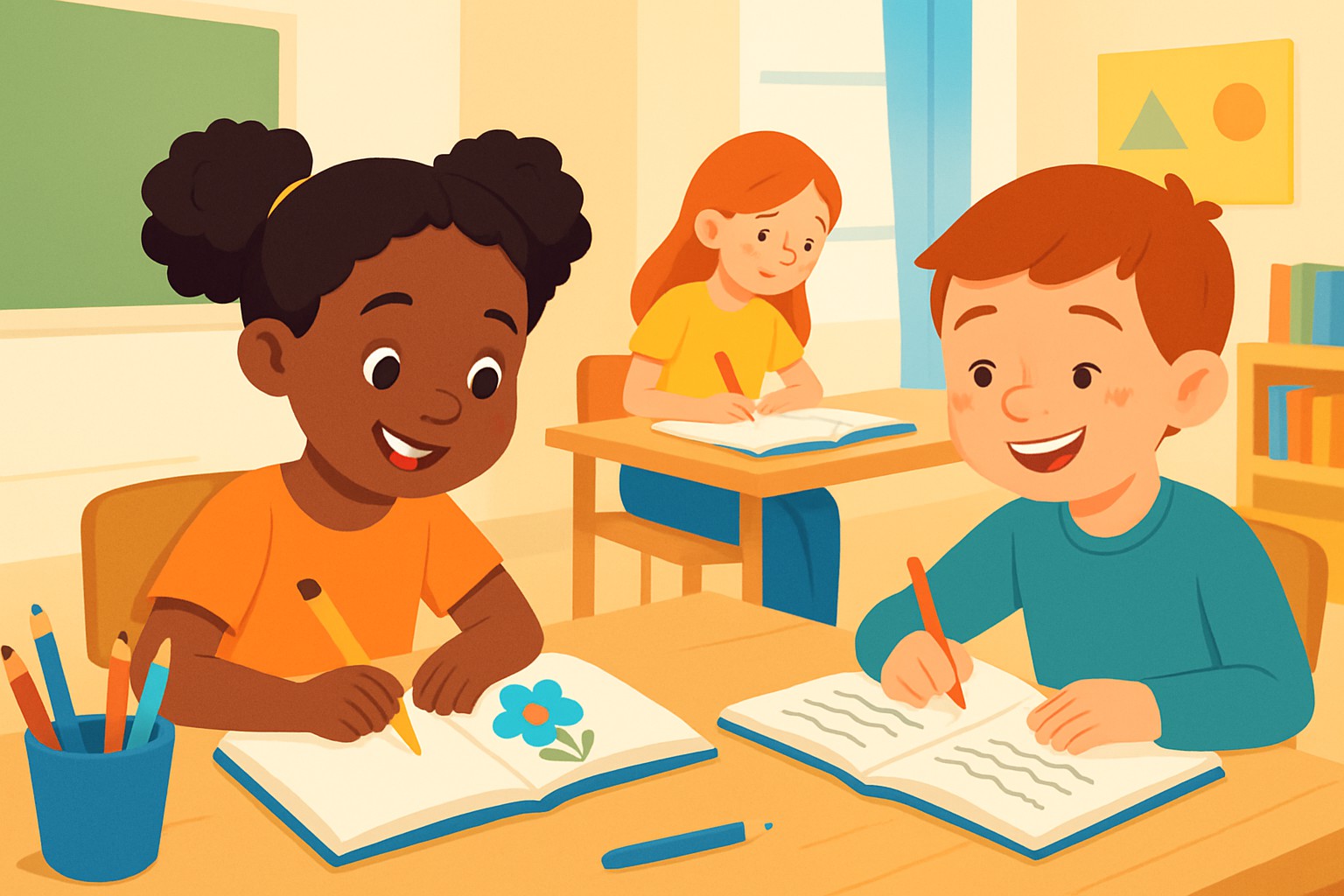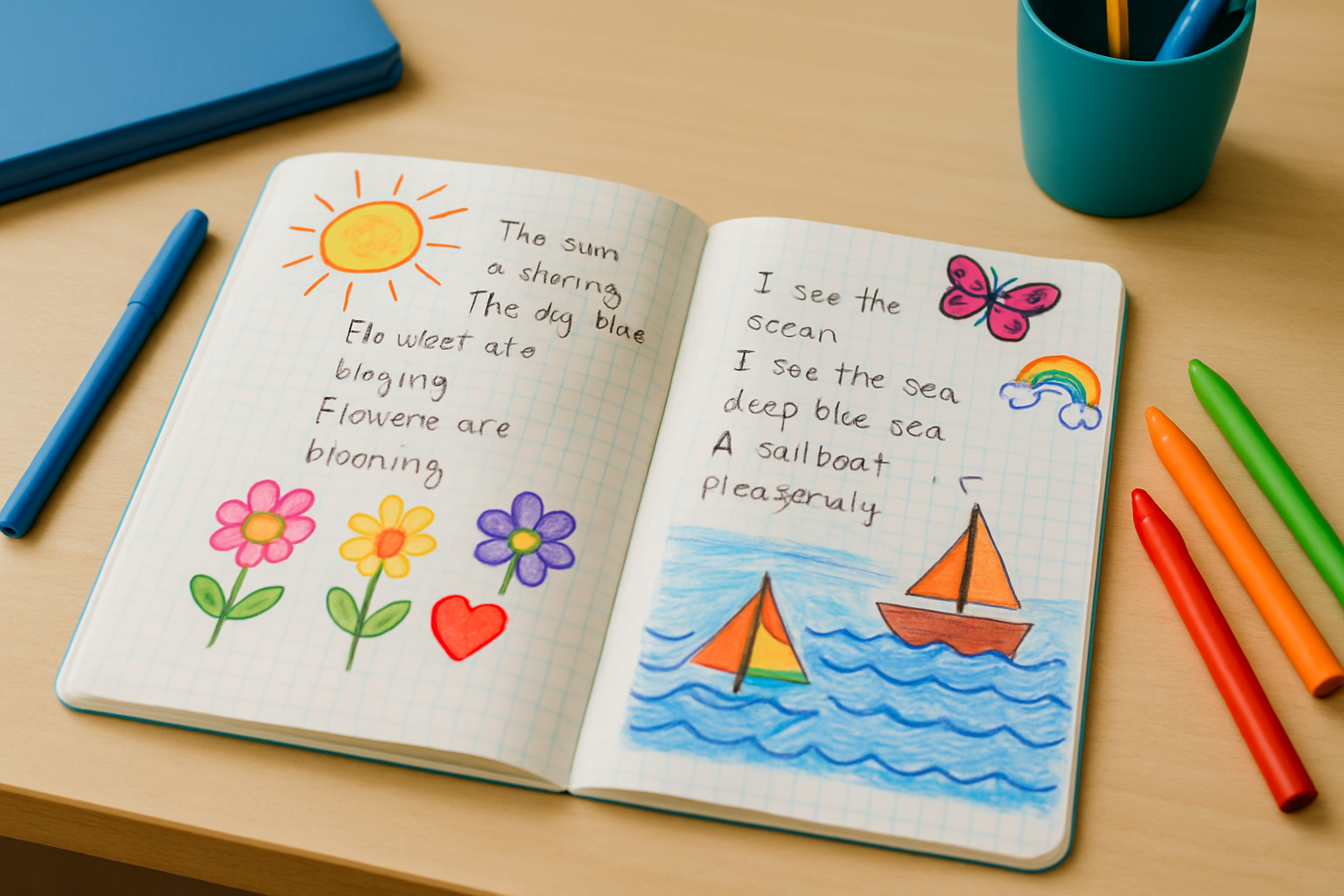Poetry Notebook - Activities for Elementary Students

Poetry notebooks often work wonders for elementary students, sparking their creativity and boosting language skills along the way.
So, What Exactly Is a Poetry Notebook?
A poetry notebook is a trusty little journal where students gather to spin their own poems. It usually holds a mix of original verses and treasured favorites penned by others, along with brainstormed sparks of inspiration and personal musings about language and feelings.
- A personal collection of poems that showcases students' own work and the sparks of inspiration behind them
- A creative playground where students can experiment with all poetic forms and styles without limits
- A handy resource for picking up fresh vocabulary and vivid imagery, catchy rhythms and clever rhymes
- A journal that gently nudges students to reflect on their emotions and life experiences through poetry
- A reliable wellspring of inspiration that builds confidence in their writing over time
Advantages of Using Poetry Notebooks in Elementary Classrooms
There’s something truly special about giving young learners a dedicated space for their poetic thoughts. Poetry notebooks in elementary classrooms are not just a fancy add-on; they open up a world where creativity can flourish in the most unexpected ways. Beyond just jotting down rhymes, these notebooks become a personal refuge where students can experiment, reflect, and play with language at their own pace.
In my experience, having a poetry notebook encourages a sense of ownership and pride in one’s work, which is no small feat for young minds still finding their voices. Plus, it gently nudges students to see writing as a dynamic, ongoing process rather than a one-and-done task. And here’s a little secret: the practice of revisiting and revising poems slowly builds confidence and resilience—skills that turn out to be invaluable far beyond the classroom walls.
So, while it might seem like just another piece of classroom paperwork on the surface, poetry notebooks are actually seeds planted for lifelong storytelling and expression.
Poetry notebooks quietly work their magic in helping elementary students boost their language skills and ignite a spark of creative thinking. They also build a lasting sense of self-confidence. These notebooks are great tools for expanding vocabulary, smoothing writing fluency, and fostering a deeper appreciation for literature.
- Gives creativity a friendly nudge by encouraging playful and imaginative ways to approach language and ideas
- Sharpens writing skills through regular practice and fun experimenting with new techniques
- Provides a cozy space for self-expression and lets students dive into their thoughts and emotions without holding back
- Strengthens critical thinking by examining poems and the choices authors make
- Aids memory retention by revisiting and reflecting on collections of poems which helps the ideas stick
Setting Up a Poetry Notebook with Handy Materials and Tips to Keep Your Thoughts Neatly in Line
Choosing the right materials and setting up the poetry notebook thoughtfully really goes a long way in keeping students engaged. Whether it’s an old-school paper notebook or a shiny digital option, having clear routines and a well-organized structure makes it easier for students to use it consistently.
- Spiral or composition notebooks are trusty durable companions you can carry anywhere and offer plenty of room to jot down all your brilliant ideas
- Digital notebooks and apps bring serious versatility by letting you mix in multimedia and edit on the fly without breaking a sweat
- Writing tools like colorful pens, pencils and markers are not just for show—they inspire creativity in a way blank pages sometimes cannot
- Decorative items such as stickers and washi tape add a fun personal touch and make it a breeze to jazz up and organize your sections just the way you like
Keeping a notebook engaging involves having students create sections like My Poems, Favorite Poems and Prompt Responses. Adding drawings or collages enhances the notebook's visual appeal.
Ways to Get Elementary Students Truly Engaged with Their Poetry Notebooks
Getting students involved in a variety of engaging poetry activities really helps them see the notebook as more than just a collection of pages—it becomes a buzzing hub for creativity. These activities could range from free-writing sessions that let their thoughts run wild, to drawing inspiration from the natural world around them. Toss in some exploration of figurative language, or team up for group projects.
Encourage daily free-writing sessions with poems to build spontaneity and make writing feel less like a chore.
Collect poetry inspired by nature by observing and describing plants, animals and the changing seasons because there is always something new hiding in plain sight.
Take a close look at your favorite poets and try mimicking their styles and forms. This is like stealing with your eyes wide open and learning along the way.
Craft sensory poems that zoom in on what you see, hear, taste, touch and smell because poetry that hits the senses stays with you longer.
Collaborate in groups to create shared poems. This sparks teamwork and turns creative thinking into a team sport.
Pair poems with drawings to deepen understanding and create a personal connection you might not expect.
Dive into poetry prompt challenges to ignite fresh ideas and overcome writer's block.
Experiment with similes and metaphors to paint your descriptions in brighter more colorful strokes.
Have fun exploring rhythm and rhyme patterns through hands-on exercises that feel more like play than work.
Keep a reflective poetry journal to track your creative journey and unpack your emotions. Think of it as your personal backstage pass.
Each activity plays its part in building certain skills. Daily free-writing nudges fluency along and sparks a laid-back kind of creativity that feels more like a chat than a chore. Meanwhile, nature-inspired prompts sharpen observation and quietly expand the vocabulary bank. Exploring poets gives a clearer picture of poetic forms and phrasing. Sensory poems invite students to paint with words in a richer and more vivid way. Writing poems together is not just about the verse; it also tightens social bonds and boosts communication skills. Adding illustrations brings a fun twist because connecting images to words feels like a mini adventure. Prompt challenges keep the momentum alive by giving a friendly nudge to keep the creative fires burning. Delving into figurative language opens a buffet of expressive options to enjoy. Playing around with rhythm and rhyme introduces a delightful sense of musicality that’s hard to resist.
Where Technology Meets the Well-Worn Poetry Notebook
Digital tools don’t just sit alongside traditional poetry notebooks—they bring them to life by adding interactive multimedia elements that catch a kid's attention. Writing apps and digital notebooks open flexible spaces where kids can write, illustrate, and share their poems, making poetry feel less like a chore and more like a fun creative adventure.
- Apps tailored for kids like Storybird or Book Creator really spark creativity whether they’re crafting stories or doodling with illustrations
- Voice-to-text features come to the rescue for students who struggle with handwriting or spelling and make the process much less frustrating
- Digital drawing tools bring pages to life with vibrant colors and multimedia elements to turn simple projects into eye-catching masterpieces
- Secure sharing platforms give students the chance to proudly publish their poems and receive feedback in a friendly atmosphere where everyone’s rooting for them
Keeping Tabs on Progress with Poetry Notebooks
Teachers can keep an eye on students' progress in their poetry notebooks by focusing on growth and effort rather than chasing perfection. This approach tends to foster a more positive mindset, which really makes a difference. Getting students involved in assessing their own work and swapping feedback with peers often provides insights that not only boost confidence but also gently nudge improvement along.
- Use rubrics that highlight creativity, effort and the clever use of poetic devices rather than just focusing on spelling
- Keep an eye on poetry portfolios regularly to catch growth in action and see how themes naturally twist and turn over time
- Set up peer sharing sessions where students can give constructive and encouraging feedback because everyone appreciates a bit of kindness with their critique
- Toss in reflective prompts that nudge students to pause and think about their own learning journeys and goals
- Help students set realistic bite-sized goals for their future poetry projects so they feel motivated rather than overwhelmed
"Helping young learners find their voice through poetry doesn’t just boost their language skills—it also quietly nurtures empathy and builds their confidence along the way. Poetry notebooks become more than just pages; they turn into a personal treasure chest of thoughts and feelings, making the whole journey both meaningful and fun." — Laura Martinez, Elementary Literacy Specialist
Suggestions for Parents to Encourage Poetry Notebook Activities at Home
Sometimes, getting kids to embrace poetry might feel like pulling teeth, but with a little creativity, it can turn into a fun, meaningful adventure. Here are some friendly tips that parents can use to gently nudge their children into enjoying their poetry notebooks at home.
Parents play a key part in nurturing a love for poetry by creating a warm, supportive space and genuinely diving into their children's poetry notebooks alongside them.
- Encourage children to jot down poems in their notebooks daily or a few times a week to make it a fun habit rather than a chore
- Read aloud a mix of poetry styles and voices together to expose them to different cultures and rhythms—think of it as a little passport for the imagination
- Celebrate every attempt at writing with genuine enthusiasm to build confidence and focus more on effort than perfect grammar or rhyme
- Provide a variety of poetry books and resources that match young readers’ interests and reading levels
- Keep poetry writing light and enjoyable by turning it into playful games or casual family activities so it never feels like homework







